 Dislikes: 0
-
Restore single stage paint on a 1991 Volvo 240 ? Question for Mike Phillips
Restore single stage paint on a 1991 Volvo 240 ? Question for Mike Phillips
Anytime I get questions via e-mail, a PM or a FB message I prefer to invest my typing time where
A: It's easier for me to share links, pictures and videos.
B: More people can read and thus benefit from the information. (no just one set of eyeballs)
The reality is, most people that contact me found me via an article I've written or a reply I've written on this forum. The thing is, instead of figuring out that the whole reason they are contacting me is because they found me via an article or answer I wrote on the forum that they to should bring their question to the forum because not only will that help them.... but it will help a future "them". If I answer everything in a private e-mail or other touch point, no one would find and contact me. It's a cycle or pattern that repeats as long as everything is shared in the public domain.
The above is kind of wordy but re-read it slowly and it will make sense.
So I get an e-mail asking,
Hey Mike,
I’m a mobile detailer and a coworker of mine has a ‘91 Volvo 240 that has badly oxidized and chalky single stage paint, non-metallic dark blue.
She would like to give the car a “facelift” as she calls it because she knows the car has old and likely thin paint. (I haven’t used my paint thickness gauge yet.) What would be a safe measurement of mils to work with in your opinion?
I read some of your articles on using Meguiar’s #7 first to rejuvenate the paint before doing any polishing. Would this be after claying the paint? I’ve read that you say clay is difficult to glide on oxidized paint, but I know this car is heavily contaminated. It’s a daily driver that is parked outside 24/7.
Also, since I’m mobile, how long would be a good minimum to let the #7 soak before removing and polishing?
Thanks,
Cody
Great questions Cody,
I have 5 articles on Meguair's #7 - you'll find people on Facebook reference them and once in a while they can even find and then share the link. Here's my article that is an INDEX of all the articles,
All Mike Phillips #7 Show Car Glaze Articles in one place
Here's the short version and "yes" follow the directions here and I'm confident you will be amazed.
The #7 Rub Down Technique by Mike Phillips
This article explains how the product and technique works and worthy of reading....
The Secret to Removing Oxidation and Restoring a Show Car Finish to Antique Single Stage Paints

(Click here for a larger picture)
Removing Oxidation Without Abrasives
Now that all the bonded contaminants have been removed off the top of the paint it's time to remove the dead oxidized paint off the surface and to some degree some of the embedded dirt and oxidation below the surface. To do this we're going to use a plush, microfiber polishing towel with some Meguiar's #7 Show Car Glaze.
Always fold your microfiber towels 4 ways
What you want to do is take your polishing towel and fold it 4 ways to create a working cloth that is large enough you can place you hand on it when working the #7 over the paint. Folding the cloth 4 ways will also provide plenty of cushion to spread out the pressure of your fingers and palm. This enables you to work gently and safely on antique, fragile paints and will also help you to avoid instilling fingermarks.
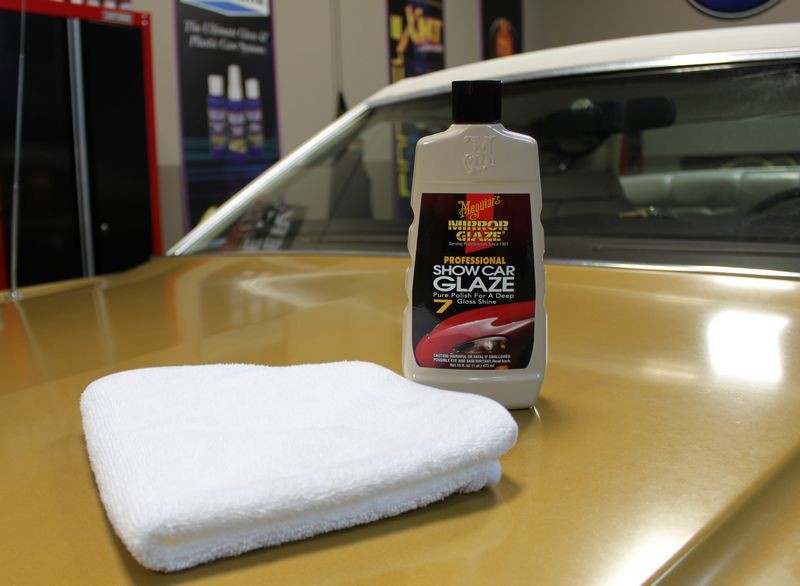
Non-abrasive abrasives...
Here's a close-up of the tufts of microfibers that make up the working face of this microfiber polishing towel. When used dry this microfiber polishing towel is soft and absorbent. The way we're going to use it however, it will still be soft and gentle to the paint except that I'm going to put a little passion behind my hand as I move this microfiber towel over the paint and the pressure I apply is going to engage the microfibers with the paint and provide a very gentle scrubbing and even abrading action.
Tufts of microfiber threads... these are your abrasives...
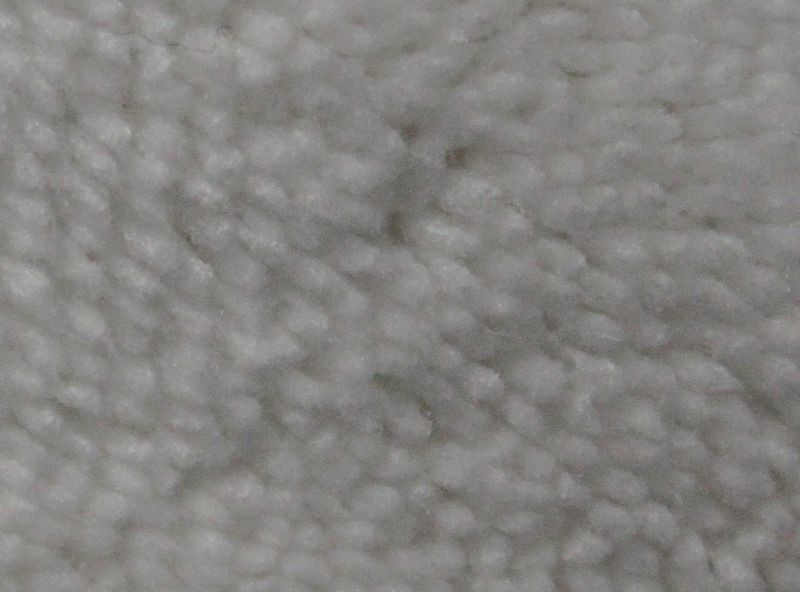
Shake well before using
Shake your bottle of #7 up exceedingly well. One of the reasons #7 used to come in clear glass bottles and later clear plastic bottles was so that you could see that the product had separated out and the hope was that as a thinking human being you would see the product had separated in the bottle and thus shake the bottle till the product had a uniform color and consistency.
After you shake the product up well you want to pour a generous amount of product out onto the face of just one side of your folded microfiber towel and note that you're going to use this one side for each panel over the entire car.
The words or terms for how much product you use goes like this,
Use the product heavy or wet
Because this is important, let me repeat these instructions...
Use the product heavy or wet!
This means you use a lot of product, you want the surface wet with product as you're working a section. You're trying to saturate the paint to gorge it with the rich polishing oils found in the #7 but you're also trying to emulsify and loosen any embedded dirt or oxidation off and out of the paint. For this car I used one full bottle on just the hood and the top of the trunk lid and most of another bottle for the passenger and driver's sides. The horizontal surfaces are always the worst because they are exposed to direct sunlight, water from rain and air-borne pollution and contaminants and thus always require the most work to clean, revitalize and restore.
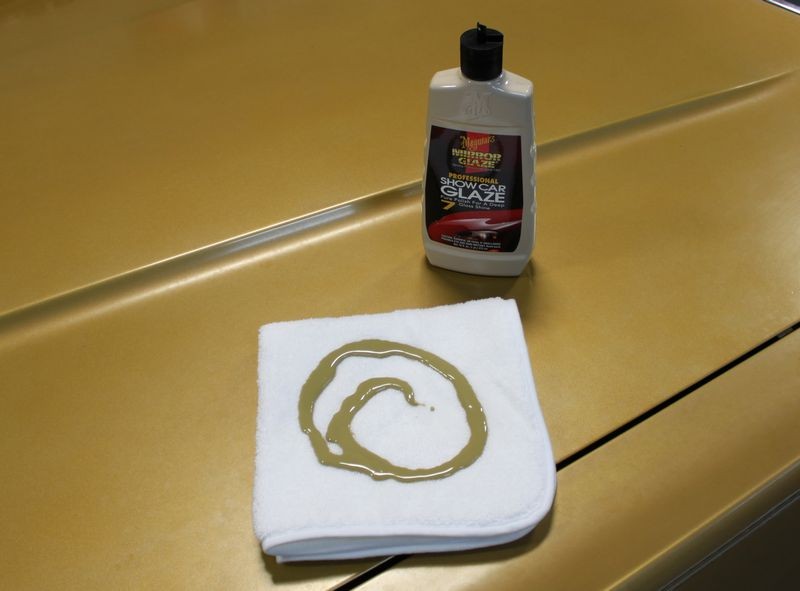
Fold the cloth into itself to spread the product out and wet the face of the cloth.
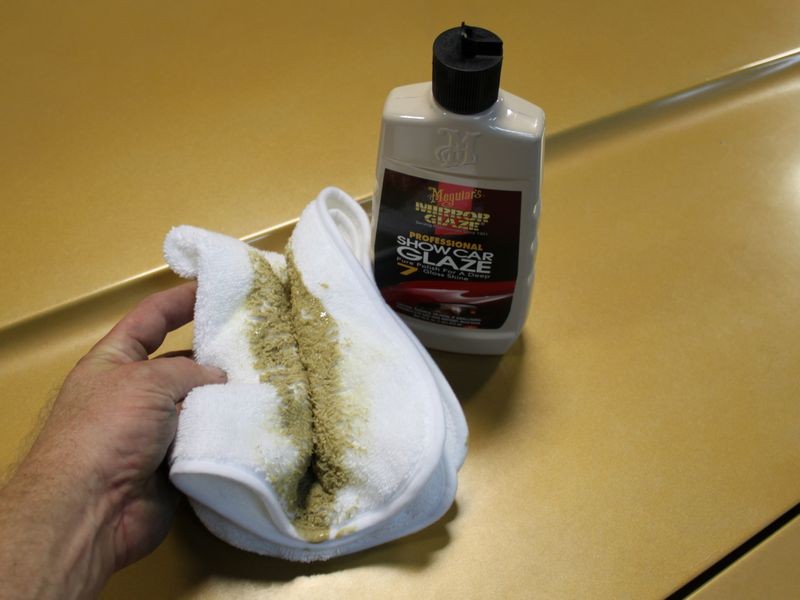
"It ain't braggin' if you can back it up" -Dizzy Dean
Now comes the passion: Start working the #7 Show Car Glaze over and into the paint in a vigorous manner. I'm in pretty good shape as I work out at the local gym and lead an active lifestyle that includes rubbing out cars both by hand and by machine.
I also dare say I'm pretty good at rubbing out cars by hand. I'm not bragging, just stating a fact that I can back up. It's more work than most people think and my point is this, rubbing this behemoth of a vehicle out by hand vigorously got me breathing hard and made my hands and arms tired.
Here's the point I'm trying to make...
If you're not breathing hard and you're not getting tired then you're not working the product over the paint vigorously enough.
Out of all the steps, this is the hardest, most time-consuming and most important step there is to do and it is this step that will determine your end results. If you don't remove the topical oxidation and embedded dirt and oxidation during this step then it will still be there when you make the final wipe to remove the wax. So put your heart and soul into this step. If you need to, take a break in-between panels.
It is vital that you work the #7 against the paint vigorously...
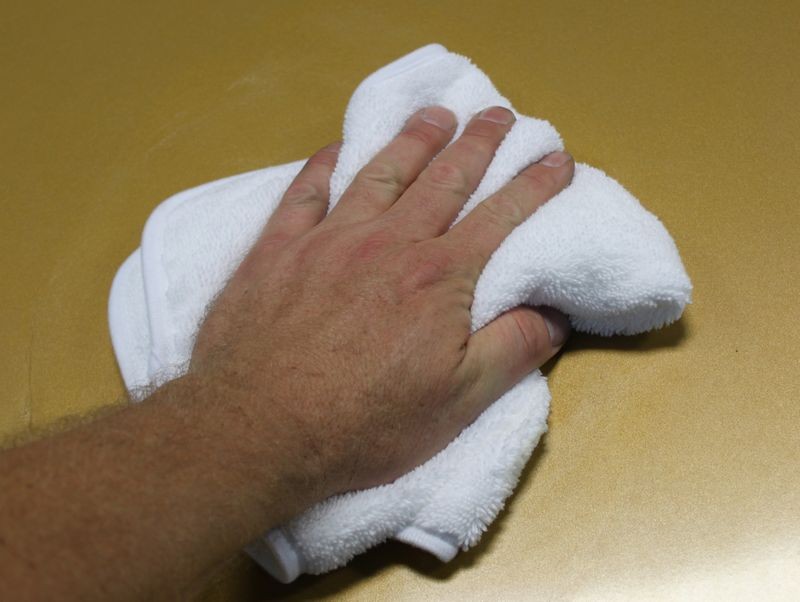
Rub out one panel at a time
After you work a small section, about 20" squarish or so, stop, re-apply fresh product and move onto a new section and be sure to overlap a little into the previous section.
- Panel = a door, the hood, the roof, etc.
- Section - a portion of a panel
Note the color being transferred onto the cloth. Part of the color you see is the color of the #7. The other part of the color is the dirt coming off and out of the paint and part of the color is the oxidation coming off the aluminum flakes.
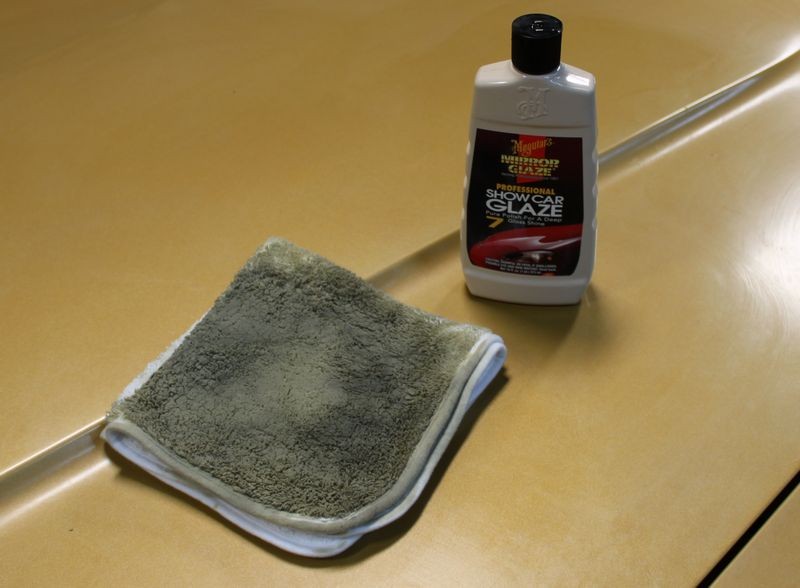
Work a panel at a time, section by section
Continue working your way around one major panel until you've worked the entire panel. In this example
This is key...
Saturation Application --> The First Application
This is a mostly unknown technique and that is to let the first application penetrate and soak into the paint for up to 24 hours before wiping the product off. The idea being to really apply the product wet and work it in really well and the walk away.
The idea is to allow the heavy concentration of oils to penetrate and seep into the paint for maximum saturation before removing the product and continuing with the process. In this case I finished applying the first application of #7 around 9:00 pm and then left the #7 to soak in until the next day. I started wiping the product off then next morning right about 10:00am.
Some will argue if this works or not but my experience is that with a porous single stage paint it does in fact help. One thing for sure it can't hurt.
Paper Test for Capillary Action
If you place a few drops of #7 onto a piece of paper and then monitor it over a few days you will see the oils in the #7 migrate or seep away from the actual drop of product. It does this through capillary action and the same thing can work to your car's paints' advantage if it's a single stage lacquer or enamel paint.
I placed a few drops about the size of a nickel on a piece of standard printer paper around 3:00pm.

The next day I took these pictures at approximately 10:00am, (19 hours later), note how the oils in the drops of #7 have migrated outward via capillary action.
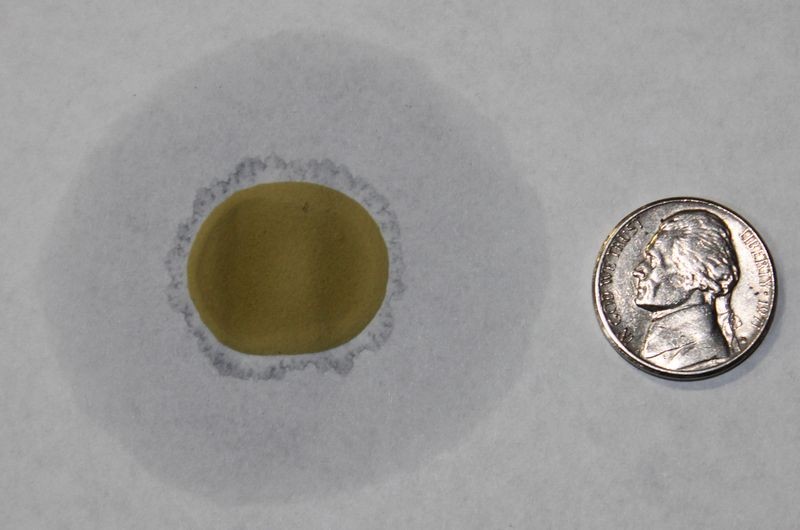
Feeder Oils penetrate or feed the paint
This same effect can take place in a single stage paint but not only will the oils travel horizontally, they will also travel vertically, that they will penetrate downward "into" your car's paint and this is where the term feeder oils comes from as the oils penetrate into or feed the paint. The result is they will condition the paint restoring some level of workability as compared to just working on old dry paint, and they will also bring out the full richness of color, something that will showcase the beauty of your car's paint.
And note this paragraph and the word in red text. Some people simply don't read, at least they don't read this paragraph and figure out I made the word important with bold red text for a reason.
 Originally Posted by Mike Phillips
What to do
If preserving the original paint is important to you then the first thing you want to do is condition the paint before working on it. Most people just jump right in and start rubbing some type of abrasive compound over old, dry, fragile paint and this will remove a lot of paint quickly and possible remove too much. Instead, take the extra step of conditioning the paint and bring it back to life with product that's been around since cars and thus car paints have been around.
As for claying before polishing?
If you do you will simply load your clay up with dead paint like I show here from an article I wrote back in 2004 - only 15 years ago as I type today in 2019
1986 Ford Bronco II - Extreme Makeover

You can do it either way, clay before and ruin a clay bar or do it after and probably be able to use the clay bar again. If you do it after - before to wipe the paint super clean and the oily #7 makes claying a bit sticky if you don't remove it all. If you remove it all then no problem and use plenty of lube.
How long to let the #7 sit?
I'd recommend rubbing in aggressively a heavy or wet application, like you see here,

Then let it soak in overnight - 24 hours. You'll need terrycloth to remove.
Hope that helps and feel encouraged to join our forum, this is where I answer questions. Email and Facebook messaging are okay, but the forum is a LOT more powerful. (think about it - it's how you found me in the first place)
Click here to join the AutogeekOnline.net car detailing discussion forum - THE best forum on the Internet

-
Post Thanks / Like - 0 Thanks, 1 Likes, 0 Dislikes
-
-
Post Thanks / Like - 0 Thanks, 1 Likes, 0 Dislikes
-
Re: Restore single stage paint on a 1991 Volvo 240 ? Question for Mike Phillips
And Cody....
I always recommend getting GREAT before shots for projects like these.... I explain why in my article here,
The power in the after shots is created in the before shots
The nutshell version of the above article is....
Once you buff out an oxidized single stage finish - you can never go back in time to get the before shots. And in most cases.... you'll regret not taking a few minutes to get these shots.

-
Post Thanks / Like - 1 Thanks, 0 Likes, 0 Dislikes
-
Re: Restore single stage paint on a 1991 Volvo 240 ? Question for Mike Phillips
Thanks for the info Mike!
I will get some current photos of the Volvo before I start anything and post them this week.
Also, I saw the video you guys did on the 1970 Mach 1 Mustang. You mentioned Meguiar’s #3 is basically the machine applicable version of #7. Is that right? Would that be a better/easier option since I do have a Griot’s 6-inch polisher?
-
Re: Restore single stage paint on a 1991 Volvo 240 ? Question for Mike Phillips
 Originally Posted by BossCody

Thanks for the info Mike!
I will get some current photos of the Volvo before I start anything and post them this week.
Also, I saw the video you guys did on the 1970 Mach 1 Mustang. You mentioned Meguiar’s #3 is basically the machine applicable version of #7. Is that right? Would that be a better/easier option since I do have a Griot’s 6-inch polisher?
No.
Believe it or not, there's something about the effectiveness of hand-rubbing the #7 using terry cloth. It's not just the nostalgia it's the loop that makes up cotton Terry cloth that gently abrades off the dead paint while pushing the oils in #7 into the paint.
A pad spinning over the surface simply cannot duplicate this action.
Something have to be experienced first-hand to be believed.
Me? I would never try to do by machine what I know works better by hand and I'm a 99.9% machine guy. Ask anyone.

-
-
Re: Restore single stage paint on a 1991 Volvo 240 ? Question for Mike Phillips
Yeah I would skip the #7 treatment.
Either polish or make it easy and fast on yourself and just hit it with a good cleaner/wax. Then stick a fork in it and call it done.

Similar Threads
-
By Mike Phillips in forum Ask your detailing questions!
Replies: 27
Last Post: 04-01-2021, 01:14 PM
-
By TMQ in forum Show N' Shine
Replies: 14
Last Post: 05-10-2019, 09:54 AM
-
By TwoFoolsAMinute in forum Auto Detailing 101
Replies: 12
Last Post: 11-19-2012, 12:57 PM
-
By Njohc in forum Auto Detailing 101
Replies: 12
Last Post: 08-08-2012, 04:43 PM
 Members who have read this thread: 0
Members who have read this thread: 0
There are no members to list at the moment.
 Posting Permissions
Posting Permissions
- You may not post new threads
- You may not post replies
- You may not post attachments
- You may not edit your posts
-
Forum Rules
|
| S |
M |
T |
W |
T |
F |
S |
| 31 |
1
|
2
|
3
|
4
|
5
|
6
|
|
7
|
8
|
9
|
10
|
11
|
12
|
13
|
|
14
|
15
|
16
|
17
|
18
|
19
|
20
|
|
21
|
22
|
23
|
24
|
25
|
26
|
27
|
|
28
|
29
|
30
| 1 | 2 | 3 | 4 |
|
Originally Posted by Mike Phillips














 Thanks:
Thanks:  Likes:
Likes:  Dislikes:
Dislikes: 









 Reply With Quote
Reply With Quote




Bookmarks